Synecdoche is a literary device in which a part of something represents the whole or it may use a whole to represent a part.

Synecdoche may also use larger groups to refer to smaller groups or vice versa. It may also call a thing by the name of the material it is made of or it may refer to a thing in a container or packing by the name of that container or packing.
Difference between Synecdoche and Metonymy
Synecdoche examples are often misidentified as metonymy (another literary device). Both may resemble each other to some extent but they are not the same.
Synecdoche refers to the whole of a thing by the name of any one of its parts.
For example, calling a car “wheels” is a synecdoche because a part of a car “wheels” stands for the whole car.
However, in metonymy, the word we use to describe another thing is closely linked to that particular thing, but is not necessarily a part of it.
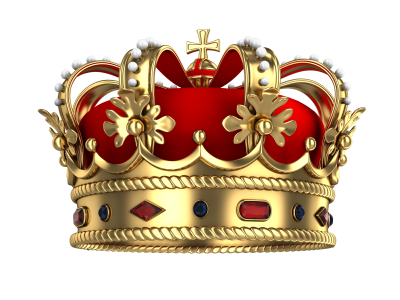 ※For example: “crown” that refers to power or authority is a metonymy used to replace the word “king” or “queen”.
※For example: “crown” that refers to power or authority is a metonymy used to replace the word “king” or “queen”.※Synecdoche Examples :
1,The word “bread” refers to food or money as in “Writing is my bread and butter” or “sole breadwinner”.
2.The phrase “gray beard” refers to an old man.
3.The word “sails” refers to a whole ship.
4.The word “suits” refers to businessmen.

suit
5.The word “boots” usually refers to soldiers.

6.The term “coke” is a common synecdoche for all carbonated drinks.
7.The word “glasses” refers to spectacles.
8.“Coppers” often refers to coins.

-----------------------------------------------------------------------------------------------------------------------

Legally Blonde
Meaning: As Elle becomes self-actualized during her rising success in law school, she ceases to so flagrantly feed this synecdoche, insisting on being seen as a whole person.
when she walks away from Warner and disappears in to the sun of the outside world, we see her entire body for only the first time from his perspective: slipping in to the haze because Warner never really knew Elle, he knew only the idea of her that he formed in his mind between her misguided visual clues and his contextualized experience of women.

-------------------------------------------------------------------------------------------------------------------
※self-actualized:to realize fully one's potential
※haze:a state of confusion
--------------------------------------------------------------------------------------------------------------------

Peter Pan
Meaning: "All hands on deck" is used as a synecdoche because hands are actually a part of a person but in this case, "hand" represents "person." So Mr. Smee means, "All people on deck!"
------------------------------------------------------------------------------------------------------------------
peter pen neverland

Neverland is a fictional location featured in the works of J. M. Barrie and those based on them. It is an imaginary faraway place, where Peter Pan, Tinker Bell, the Lost Boys and other creatures and beings live. Although not all people who come to Neverland cease to age, its best known resident famously refused to grow up, and it is often used as a metaphor for eternal childhood , immortality, and escapism.

*Nature of Neverland
Barrie explains that the Neverlands are found in the minds of children, and that although each is "always more or less an island", and they have a family resemblance, they are not the same from one child to the next. The novel further explains that the Neverlands are compact enough that adventures are never far between. It says that a map of a child's mind would resemble a map of Neverland, with no boundaries at all.
The exact situation of Neverland is ambiguous and vague.
The passage of time in Neverland is also ambiguous. The novel Peter Pan mentions that there are many more suns and moons there than in our world, making time difficult to track, and that the way to find the time is to find the crocodile, as there is a clock inside it. Although widely thought of as a place where children don't grow up, Barrie wrote that the Lost Boys eventually grew up and have to leave, and fairies there lived typically short lifespans.

-------------------------------------------------------------------------------------------------------------------
Peter Pan's Dark Orgins
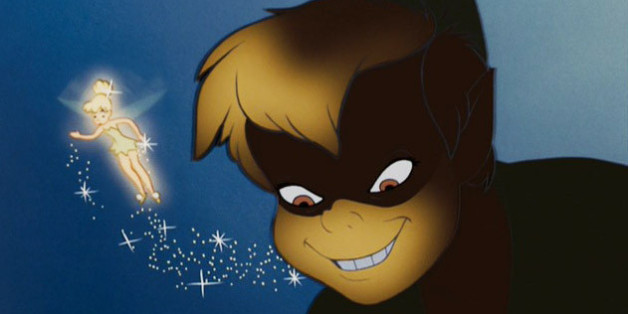
It's no shocker that the timeless tale of Peter Pan has questionable content that kids just shouldn’t be exposed to. Moral messages such as “never grow up...do whatever you want”, “it's okay to kill”, and “pedophilia”.
After all, Peter Pan was named after the greek god of sexual deviance, rape, and torture. We’ll get to that in just a moment.
What you might not be aware of though is just how dark the origin of the story truly is. You might want to rethink exposing any young impressionable mind to its rebellious influence.
The story was originally written by James Matthew Barrie born in 1860. He lost his thirteen year old brother in an ice skating accident… His mother never fully recovered mentally from the incident. She would even dress J.M Barrie up as his brother to pretend the boy still lived. Upon growing up, Barrie becomes a writer and in 1891 marries actress Mary Ansell, a marriage that was, in the words of his colleagues…never consummated. Mary has an affair with another writer and the marriage is shattered by divorce. Barrie, devastated by the ordeal, is walking his dog in a nearby park and meets the Davies family. The 1994 film titled “Finding Neverland” with Johnny Depp is based on J.M Barries experience meeting the Davies.
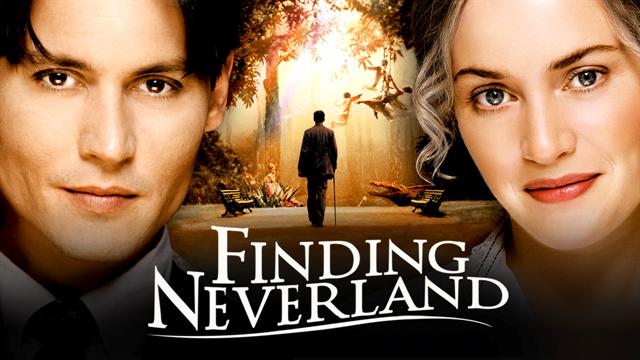

Nevertheless, Barrie quickly takes to the boys, George, Jack, and baby Peter and becomes a regular visitor at the their household, earning him the title of “uncle Jim”. Barrie uses the Davies family as subjects for his writings and is especially inspired by the young baby Peter, naming the character Peter Pan after him.
Peter Pan made his first official appearance in the book titled “The Little White Bird”, Barrie’s thinly veiled novel about George Llewelyn Davies that, today, with our sensitivity to sexual predators, has a creepy tone. In the book, a boy named David is befriended by the narrator, who pretends to have a son of his own who died. He uses this lie to create empathy with David’s parents. The narrator is particularly excited that David’s mother, Mary, has been duped, which allows him to “take [David] utterly from her and make him mine.” Within the novel, the narrator invents a story about a magical boy named Peter Pan who never grows old, and who lives in Kensington Gardens. The character was then developed into its own book where the story has Peter Pan killing anyone who chooses to grow up.
Now why J.M Barrie created the character after the sexually twisted Greek god Pan is disturbing in and of itself.
Even more ironic is that in Barrie’s personal life accusations of foul play began to surface. Claims that the relationship Barrie built with the Davies boys (especially Michael) was of an inappropriate manner. One such letter was written to Michael on his 8th birthday.
“I wish I could be with you and your candles. You can look on me as one of your candles, the one that burns badly — the greasy one that is bent in the middle. But still, hurray, I am Michael’s candle. I wish I could see you putting on the redskin’s clothes for the first time… Dear Michael, I am very fond of you, but don’t tell anybody.”
In an autobiography by Piers Dudgeon, Neverland: J.M. Barrie, the Du Mauriers, and the Dark Side of ‘Peter Pan’, Dudgeon unravels some pretty incriminating evidence that there was more to Barrie’s attachment to the Davies children than simple protective friendship.
Barrie was also known to have had friendships with other children, both before he met the Davies boys and after they had grown up. There has since been accusations that Barrie was a paedophile. One source for the speculation is due to a scene in the novel “The Little White Bird”, in which the protagonist (who resembles Barrie) helps a small boy undress for bed, and at the boy's request they sleep in the same bed.
Barrie suffered bereavements with the boys, losing the two to whom he was closest in their early twenties.
George was killed in World War I.
Michael, with whom Barrie corresponded daily while at boarding school and university, drowned in 1921, with his friend and possible lover, Rupert Buxton, at a known danger spot at Sandford Lock near Oxford, one month short of his 21st birthday. Some years after Barrie's death, Peter compiled his morgue from family letters and papers, interpolated with his own informed comments on his family and their relationship with Barrie. Peter died by throwing himself in front of a train shortly after completing the work.
Our modern idea of what the Devil looks like comes from depictions of Pan with his horns and goat feet. According to the Greek myths, Pan is known for his sexual perversion. This is perhaps the reason modern depictions of him in cartoons and movies show him corrupting the female characters.
Disney‘s white washed version of the character has toned down the sexual perversion but still retains the “devil-like” attributes. Enticing the little girl to leave her parents authority and go to a place with no rules… “there is only one thing you have to do… leave home behind and you can never come back”. It's the same lie Lucifer told the angels in heaven… “don’t you want to go to a place where we don’t ever have to follow the rules… all you have to do is leave home behind and you can never ever come back?” Pans friends, not accidentally called “the lost boys” inhabit an island called “Neverland”. Where “selfishness” and “do what thou wilt” is the rule of the day. Kind of sounds like a similar story where a bunch of “pirates” or “Lost Angels” inhabit this “island in space” called planet earth.
Michael Jackson was so obsessed with the story of Peter Pan that he ended up building his own private theme park in his backyard called “Neverland”. Like Barrie, Jackson seems to have an infatuation with the sexual deviant god Pan, as depicted in the artwork hanging in his studio. The painting has Jackson surrounded with naked little boys and girls while holding the Pan pipes. His ranch full of sculptures of little boys and girls. The very flag and logo for the Neverland Ranch is of a little boy.
Needless to say, Disney is simply repackaging this dark tale.
In fact, many of the Disney classics are based off of extremely dark books. Entertainment Tonight wrote an entire article outlining the origins of some of these beloved stories.
So don’t get lured into the darkness of Pan. Don’t expose yourself to the rebellious spirit. Instead, open your Bible and behold the greatest story ever told. One of salvation from selfishness and eternal destruction. A story that has the happiest ending of all, a returning home to the gift of eternal life. Now that is something worth believing in.

And as always, remember to pray for people who make these movies. We are all in need of a savior. And like the apostle Peter tells us in 2 Peter 3:9,
“The Lord is not slack concerning his promise, as some men count slackness; but is long-suffering to us-ward, not willing that any should perish, but that all should come to repentance."
-------------------------------------------------------------------------------------------------------------
※pedophilia:sexual feelings or activities that involve children
※ordeal: an experience that is very unpleasant or difficult
※foul:very bad or unpleasant
※accusation:
a claim that someone has done something wrong or illegal OR a charge that someone has committed a fault or crime
※paedophile:a person who has a sexual interest in children
※bereavement: the death of a family member or friend
※morgue:
a place in the editorial offices of a newspaper, magazine, etc., where old articles and other documents are kept
※interpolated:especially : to put (words) into a piece of writing or a conversation
※perversion:sexual behavior that people think is not normal or natural
※entice:to attract (someone) especially by offering or showing something that is appealing, interesting, etc.
※infatuation: to inspire with a foolish or extravagant love or admiration
※slack:not busy ; lacking the expected or desired activity
※repent: to feel sorry, self-reproachful, or contrite for past conduct;
-----------------------------------------------------------------------------------------------------------------
★-phobia
word-forming element meaning "excessive or irrational fear of," from Latin -phobia and directly from Greek -phobia "panic fear of,
.In widespread popular use with native words from c. 1800.
For example:
1,Islamophobia:hostility or discrimination against Muslims
---------------------------------------------------------------------------------------------------------------------
One of the Greatest Knights of the Round Table &King Arthur's greatest companion Lancelot

was one of the Knights of the Round Table in the Arthurian legend. He typically features as King Arthur's greatest companion, and the greatest swordsman and jouster of the age — until his adultery with Queen Guinevere is discovered, causing a civil war exploited by Mordred which brings about the end of Arthur's kingdom.
(*Mordred is a character in the Arthurian legend, known as a notorious traitor who fought King Arthur at the Battle of Camlann, where he was killed and Arthur fatally wounded.)

Mordred
Lancelot's life and adventures have been featured in several medieval romances, often with conflicting background stories and chains of events.

------------------------------------------------------------------------------------------------------------------
Guinevere---A Queen for a Kingdom

Guinevere, was the wife of King Arthur of legend. In medieval romances, one of the most prominent story arcs is Queen Guinevere's love affair with her husband's chief knight, Lancelot.

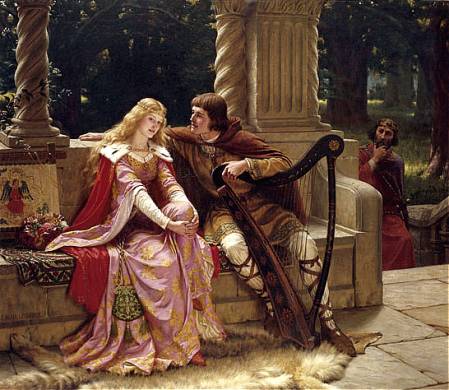
Guinevere and Lancelot
-----------------------------------------------------------------------------------------------------------

The Band Perry’s If I Die Young is based on the Arthurian Legend The Lady of Shallot
*in the video Kimberley Perry is shown mimicking the Lady of Shallot and holding a book of Tennyson poetry. The video ends showing the book opened up to “The Lady of Shalott”.
*There is this lyrics DOWN BELOW:
If I die young, bury me in satin
Lay me down on a bed of roses
Sink me in the river at dawn
Send me away with the words of a love song,
Uh oh, Uh oh
Lord make me a rainbow, I'll shine down on my mother
She'll know I'm safe with you when she stands under my colors
Oh, and, life ain't always what you think it ought to be, no
Ain't even grey, but she buries her baby
The sharp knife of a short life
Oh well, I've had just enough time
If I die young, bury me in satin
Lay me down on a bed of roses
Sink me in the river at dawn
Send me away with the words of a love song
The sharp knife of a short life
Oh well, I've had just enough time
And I'll be wearing white when I come into your kingdom
As green as the ring on my little cold finger
I've never known the loving of a man
But it sure felt nice when he was holding my hand
There's a boy here in town, says he'll love me forever
Who would have thought forever could be severed by
The sharp knife of a short life
Oh well, I've had just enough time
So put on your best, boys and I'll wear my pearls
What I never did is done
A penny for my thoughts, oh no, I'll sell 'em for a dollar
They're worth so much more after I'm a goner
And maybe then you'll hear the words I've been singing
Funny, when you're dead how people start listen'n
If I die young, bury me in satin
Lay me down on a bed of roses
Sink me in the river at dawn'
Send me away with the words of a love song
The ballad of a dove
Go with peace and love
Gather up your tears, keep 'em in your pocket
Save them for a time when you're really gonna need them,
The sharp knife of a short life oh
Well, I've had just enough time
So put on your best boys
And I'll wear my pearls
---------------------------------------------------------------------------------------------------------------
※satin: cloth that has a smooth, shiny surface

satin
※ballad:a slow popular song that is typically about love
※goner:someone or something that is going to die or that can no longer be used
-----------------------------------------------------------------------------------------------------------------

Lady of Shallot is found in the story Lancelot and Elaine in which Elaine falls in love with Lancelot but Lancelot, in love with Guinevere, says he does not love her.
So Elaine “dies of heartbreak” her brothers and father send her down the river in a boat with a letter to Lancelot and Guinevere. This story is what makes Lancelot see his mistakes and what he could have had.
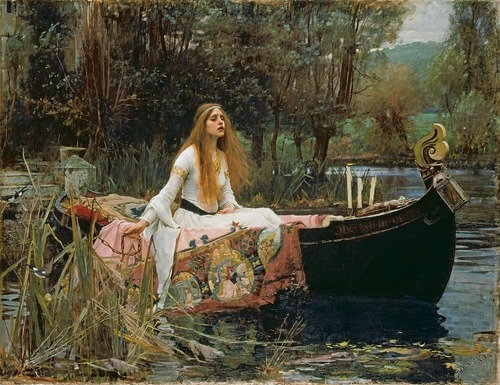
Illustration by W. E. F. Britten for a 1901 edition of Tennyson's poems
Out flew the web and floated wide-
The mirror crack'd from side to side;
"The curse is come upon me," cried
The Lady of Shalott.
She leaves her tower, finds a boat upon which she writes her name, and floats down the river to Camelot. She dies before arriving at the palace. Among the knights and ladies who see her is Lancelot, who thinks she is lovely.
"Who is this? And what is here?"
And in the lighted palace near
Died the sound of royal cheer;
And they crossed themselves for fear,
All the Knights at Camelot;
But Lancelot mused a little space
He said, "She has a lovely face;
God in his mercy lend her grace,
The Lady of Shalott."
※Summary from Sparknotes
Part 1: The poem opens with a description of a field by a river. There's a road running through the field that apparently leads to Camelot, the legendary castle of King Arthur. From the road you can see an island in the middle of the river called the Island of Shalott. On that island there is a little castle, which is the home of the mysterious Lady of Shalott. People pass by the island all the time, on boats and barges and on foot, but they never see the Lady. Occasionally, people working in the fields around the island will hear her singing an eerie song.
Part 2: Now we actually move inside the castle on the island, and Tennyson describes the Lady herself. First we learn that she spends her days weaving a magic web, and that she has been cursed, forbidden to look outside. So instead she watches the world go by in a magic mirror. She sees shadows of the men and women who pass on the road, and she weaves the things she sees into her web. We also learn that she is "half sick" of this life of watching and weaving.
Part 3: Now the big event: One day the studly Sir Lancelot rides by the island, covered in jewels and shining armor. Most of this chunk of the poem is spent describing Lancelot. When his image appears in the mirror, the Lady is so completely captivated that she breaks the rule and looks out her window on the real world. When she does this and catches a glimpse of Lancelot and Camelot, the magic mirror cracks, and she knows she's in trouble.
Part 4: Knowing that it's game over, the Lady finds a boat by the side of the river and writes her name on it. After looking at Camelot for a while she lies down in the boat and lets it slip downstream. She drifts down the river, singing her final song, and dies before she gets to Camelot. The people of Camelot come out to see the body of the Lady and her boat, and are afraid. Lancelot also trots out, decides that she's pretty, and says a little prayer for her.
-----------------------------------------------------------------------------------------------------------------
Was Guinevere really an adulteress?
The legends, of course, would change this rescuer to Lancelot and would incorporate this story into the Love Triangle aspect of the relationship between Arthur's best knight and his queen. But Lancelot is entirely the creation of Chretien de Troyes and is as such no part of historical investigation. As for Mordred, whom Geoffrey calls Modred and whom scholars think was also called Medraut, the tale of his seizing the throne with the help of the queen is to be found in Geoffrey. Later writers would hold Guinevere blameless in this, but Geoffrey says she broke her marriage vows to Arthur and settled in as Modred's queen. When Arthur returned to fight his nephew, Guinevere fled to a nunnery (Geoffrey doesn't say which) and lived out her days there in penitance.
Explorations in Arthurian Legend>>
We can point to one man to give us the Lancelot-Guinevere adultery story: Chretien de Troyes. He it was who invented Lancelot and added him to Arthur's court as a Knight of the Round Table.
Other writers would build on this theme. Sir Thomas Malory put forward the idea that Arthur's continuing to turn a blind eye (or not knowing at all) would serve as a measure of mistrust of his authority by his knights; they also would doubt his ability to rule if he couldn't see or admit such an obvious thing. Malory would add the story of how Arthur found his queen guilty of treason and sentenced her to death by being burned at the stake and how Lancelot rescued her and carried her off. Arthur and Lancelot fought, of course, and Malory follows Geoffrey in placing Guinevere in a nunnery.
Tennyson finds the adultery to be the cause of all that is wrong with Arthur's court. Because of his sin, Lancelot cannot behold the full glory of the Holy Grail. Because of the sin's being known, Balin and Pelleas go mad. Modern writers would treat the adultery as a matter of course and even suggest that it was inevitable becaue Guinevere didn't really love Arthur.
------------------------------------------------------------------------------------------------------------------------
courtly love
Courtly love was a medieval European literary conception of love that emphasized nobility and chivalry(1.very polite, honest, and kind behaviour, especially by men towards women
2,the system of behaviour followed by knights in the medieval period of history, that put a high value on honour, kindness, and courage:).
Medieval literature is filled with examples of knights setting out on adventures and performing various services for ladies because of their "courtly love". This kind of love is originally a literary fiction created for the entertainment of the nobility, but as time passed, these ideas about love changed and attracted a larger audience. In the high Middle Ages, a "game of love" developed around these ideas as a set of social practices.
"Loving nobly" was considered to be an enriching and improving practice
Courtly love began in the ducal and princely courts of Aquitaine, Provence, Champagne, ducal Burgundy and the Norman Kingdom of Sicily at the end of the eleventh century. In essence, courtly love was an experience between erotic desire and spiritual attainment,
"a love at once illicit and morally elevating, passionate and disciplined, humiliating and exalting, human and transcendent".
-------------------------------------------------------------------------------------------------------------------------
※ducal: of or relating to a duke
※elevate:to lift (something) up
※illicit:involving activities that are not considered morally acceptable
※transcendent:going beyond the limits of ordinary experience
※exalt:to feel or show great happiness
----------------------------------
Stages of courtly love
Attraction to the lady, usually via eyes/glance
Worship of the lady from afar
Declaration of passionate devotion
Virtuous rejection by the lady
Renewed wooing with oaths of virtue and eternal fealty
Moans of approaching death from unsatisfied desire (and other physical manifestations of lovesickness)
Heroic deeds of valor which win the lady's heart
Consummation of the secret love
Endless adventures and subterfuges avoiding detection.
-------------------------------------------------------------------------------------------------------------------
※afar: from, to, or at a great distance
※woo: to try to make someone love you : to try to have a romantic relationship with someone
※fealty: loyalty to a person, group
※valor: courage or bravery*
※subterfuge:he use of tricks especially to hide, avoid, or get something
----------------------------------------------------------------------------------------------------------------------
Courtly Love Today:

Despite attempts to dismiss courtly love as something that has never existed outside of pathological male fantasies and literature, excepts from the following academic study shows that indeed it was, and still is, supported by real persons of both sexes.
Abstract:
Summary.-This pilot study measured current acceptance of medieval rules of love operationalized in two scales adapted from an important 12th-century Latin treatise about courtly love. One item about a doctrine in the treatise was added to measure “perfect” love.
There was general acceptance that women expect men to follow medieval rules of love concerning Male Courtesy. Some significant sex and ethnic differences were found, especially in regard to Action Norms. Results were interpreted to modify current understanding of courtly love by identifying men’s courtesy as a prerequisite for love. Demographic variables were interpreted as evidence of cultural scripts that program romantic experience to give women social and personal control of men.
Courtly Love as a Vehicle For Feminine Control
By developing ways to handle the excess of men to women, medieval courtly love provided alternative behaviors besides violence to resolve conflict . By including norms that also can be related to courtesy, courtly love taught men a way to express tenderness rather than just erotic passion , and legitimated a level of control for women in heterosexual relationships analogous to their increased domestic power in the 12th century.
Although recognizing this new power, Lafitte-Houssat claimed 12th-century men only fictionalized women “as a feudal sovereign”. Similarly, Duby considered courtly love an escapist male fantasy. Boone argued that the image of courtly love “maintained a hierarchy of male dominance” . However, medieval courtly love also provided women a structure to contest for personal control. This empowerment gave society a way to structure the darker side of passionate love identified by Peele as addictive love.
Research is necessary to determine the possibility that women determine men’s cultivated behavior by establishing an image of themselves as sovereigns to control male fantasies, rather than being enthroned by male patriarchy. Incorporating the operative Courtesy Norms into current love scales could expand our view of the scripts which direct erotic fantasies and judgements about relationships. Finally, responses of other ethnic and Hispanic groups to selected items, especially about courtesy and obsessiveness, could be analyzed.
--------------------------------------------------------------------------------------------------------------
※treatise:
a systematic exposition or argument in writing including a methodical discussion of the facts and principles involved and conclusions reached .
※pathological:
extreme in a way that is not normal or that shows an illness or mental problem.
※prerequisite:
something that you officially must have or do before you can have or do something else.
※demographic:
of or relating to the study of changes that occur in large groups of people over a period of time
※heterosexual:
sexually attracted to people of the opposite sex
※analogous:
similar in some way
※feudal:
of or relating to feudalism
※feudalism:
a social system that existed in Europe during the Middle Ages in which people worked and fought for nobles who gave them protection and the use of land in return.
Daisy Miller by henry james

Annie "Daisy" Miller and Frederick Winterbourne first meet in Vevey, Switzerland, in a garden of the grand hotel where Winterbourne is allegedly vacationing from his studies.They are introduced by Randolph Miller, Daisy's 9-year-old brother. Randolph considers their hometown of Schenectady, New York, to be absolutely superior to all of Europe. Daisy, however, is absolutely delighted with the continent, especially the high society she wishes to enter.
Winterbourne is at first confused by her attitude, and though greatly impressed by her beauty, he soon determines that she is nothing more than a young flirt. He continues his pursuit of Daisy in spite of the disapproval of his aunt, Mrs. Costello, who spurns any family with so close a relationship to their courier as the Millers have with their Eugenio. She also thinks Daisy is a shameless girl for agreeing to visit the Château de Chillon with Winterbourne after they have known each other for only half an hour. The next day, the two travel to Château de Chillon and although Winterbourne had paid the janitor for privacy, Daisy is not quite impressed. Winterbourne then informs Daisy that he must go to Geneva the next day. Daisy feels disappointment and chaffs him, eventually asking him to visit her in Rome later that year.
In Rome, Winterbourne and Daisy meet unexpectedly in the parlor of Mrs. Walker, an American expatriate. Her moral values have adapted to those of Italian society. Rumors about Daisy meeting with young Italian gentlemen make her socially exceptionable under these criteria. Winterbourne learns of Daisy's increasing intimacy with a young Italian of questionable society, Giovanelli, as well as the growing scandal caused by the pair's behavior. Daisy is undeterred by the open disapproval of the other Americans in Rome, and her mother seems quite unaware of the underlying tensions. Winterbourne and Mrs. Walker attempt to persuade Daisy to separate from Giovanelli, but she refuses any help that is offered.
One night, Winterbourne takes a walk through the Colosseum and sees a young couple sitting at its center. He realizes that they are Giovanelli and Daisy. Winterbourne, infuriated with Giovanelli, asks him how he could dare to take Daisy to a place where she runs the risk of catching "Roman Fever". Daisy says she does not care and Winterbourne leaves them. Daisy falls ill and dies a few days later.

※Daisy Miller was first published in the June and July 1878 issues of the British magazine Cornhill. It was an instant success, transforming James into an author of international standing. The novel’s popularity almost certainly derived from the portrait at its center, of a naïve, overly self-confident, and rather vulgar American girl attempting to inhabit the rarified atmosphere of European high society.
The post–Civil War industrial boom had given rise to a new class of wealthy Americans for whom “the grand tour,” an extended trip through Europe, represented the pinnacle of social and financial success. As a result, Americans were visiting Europe for the first time in record numbers. However, American manners differed greatly from European manners, and the Americans were largely ignorant of the customs of Europeans of comparable social status. Between these two groups lay a third: wealthy American expatriates whose strict observance of the Old World standards of propriety outdid even the Europeans.
Daisy Miller, fresh from the high society of Schenectady, New York, neither knows nor cares about local notions of propriety, and the conflict between her free-spirited foolishness and the society she offends is at the heart of the novel. Daisy Miller has been hailed as the first “international novel,” but it is also an early treatment of another theme that was to absorb James throughout his career: the phenomenon of the life unlived. In a novel incorporating this theme, the protagonist, owing to some aspect of his or her own character, such as an unconscious fear or a lack of passion or feeling, lets some opportunity for happiness go by and realizes it too late. In Daisy Miller, such a protagonist is Winterbourne, who spends the entire novel trying to figure out Daisy. In fact, it has been argued that Daisy Miller isn’t really so much about Daisy herself as it is about Winterbourne’s wholesale failure to understand her.
----------------------------------------------------------------------------------------------------------
oxymoron
As with many other literary and rhetorical devices, oxymorons are used for a variety of purposes. Sometimes they are used to create some sort of drama for the reader or listener, and sometimes they are used to make the person stop and think, whether it's to laugh or to ponder.
One famous oxymoron is the phrase "the same difference." This phrase qualifies as an oxymoron because the words "same" and "difference" have completely opposite meanings. Therefore, bringing them together into one phrase produces a verbally puzzling, yet engaging, effect.
Oxymorons from Everyday Life:
Great Depression
Jumbo shrimp
Cruel to be kind
Pain for pleasure
Clearly confused
Act naturally
Beautifully painful
Painfully beautiful
Deafening silence
Pretty ugly
Pretty fierce
Pretty cruel
Definitely maybe
Living dead
Walking dead
Only choice
Amazingly awful
Alone together
Virtual reality
Random order
Original copy
Happy sad
Disgustingly delicious
Run slowly
Awfully good
Awfully delicious
Small crowd
Dark light
Light darkness
Dark snow
Open secret
Passive aggressive
Appear invisible
Awfully lucky
Awfully pretty
Big baby
Tiny elephant
Wake up dead
Goodbye reception
Growing smaller
Least favorite
True myth
Typically weird
Typically odd
Naturally strange
Weirdly normal
Unpopular celebrity
Worthless gold
Sad joy
Liquid food
Heavy diet
Noticeable absence
Quiet presence
Short wait
Sweet agony
Sentence Examples with Oxymorons
There are some well-known sentences and quotations that make use of oxymorons. Seeing oxymorons used in context often helps to provide a better idea of how and why they are used.
"I can resist anything, except temptation." - Oscar Wilde
"I like a smuggler. He is the only honest thief." - Charles Lamb
"And faith unfaithful kept him falsely true." - Alfred Tennyson
"Modern dancing is so old fashioned." - Samuel Goldwyn
"A business that makes nothing but money is a poor business." - Henry Ford
"I am busy doing nothing." - Oxymorons
"A little pain never hurt anyone." - Word Explorations
"I am a deeply superficial person." - Andy Warhol
"No one goes to that restaurant anymore - It's always too crowded." - Yogi Berra
"We are not anticipating any emergencies." - Word Explorations
"A joke is actually an extremely really serious issue." - Winston Churchill
"I like humanity, but I loathe persons." - Edna St. Vincent Millay
"Always be sincere, even though you do not necessarily mean it." - Irene Peter
"I generally advise persons never ever to present assistance." - P.G. Wodehouse
For more oxymoron quotes, check out Examples of Funny Oxymoron Quotes.

※Purpose of Oxymorons
Why use phrases that do not speak to make any logical sense?
I.Dramatic Effect
Saying that a picture or a scene is "painfully beautifully" calls attention to the speaker and the object of inquiry. Such a phrase shows that an object can have two different qualities at once, making it a subject for study and analysis.
II.Adding Flavor to Speech
When someone says a phrase such as "naturally weird" or "unpopular celebrity," the speaker is finding a new way to describe that individual or object. Adding the adverb "naturally" to the first phrase makes it even more apparent that the subject of discussion is rather unusual, as opposed to the effect that simply the word "weird" would have.
III.For Entertainment
Sometimes people are not trying to make a profound declaration when they use oxymorons. Instead, they want to be witty and to show that the can use words to make people laugh. One example of this use of oxymoron is the example in which Oscar Wilde comically reflects on the fact that he is actually not able to resist much at all.
沒有留言:
張貼留言